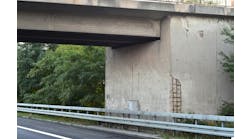By: Becca Lane, P.E., and Tom Kazmierowski, P.E.
Cold in-place recycling (CIR) is an established in-situ pavement rehabilitation method that recycles 75 to 125 mm of an existing hot-mix asphalt (HMA) pavement, sizes it, mixes in additional asphalt cement and lays it back down without offsite hauling and processing. The added asphalt cement is typically emulsified asphalt, a blend of asphalt cement and water. The material is then profiled and compacted to form a binder course. A new HMA surface is placed after the emulsion has set and moisture and compaction requirements have been met.
A recent innovative development in CIR technology is the use of expanded (foamed) asphalt, rather than emulsified asphalt, to bind the mix. In this process, hot asphalt cement is pumped through an expansion chamber on the cold recycling unit, where a small amount (1%) of cold water is injected and immediately vaporizes. This creates thousands of tiny bubbles within the hot asphalt cement causing it to rapidly expand (foam). The expanded asphalt is then mixed with the reclaimed asphalt pavement. As with conventional CIR, the material is then profiled and compacted to form a binder course. This combination of CIR and expanded asphalt technologies results in 100% recycled material referred to as cold in-place recycled expanded asphalt mix (CIREAM).
With conventional CIR, the Ministry of Transportation Ontario (MTO) specifies a minimum 14-day curing period to allow the emulsion to set and moisture and compaction requirements to be met. Application of CIR is usually limited to the warmer, drier months. The major advantage of CIREAM is that a new HMA surface can be applied following a two-day curing period, provided compaction requirements have been met. The process is less dependent on warm, dry weather for placement, so it leads to an extended construction season.
MTO constructed a trial section of CIREAM on Highway 7, east of Perth, Ont., in July 2003. A 5-km trial section of CIREAM was constructed adjacent to 7 km of conventional CIR mix, giving MTO an excellent opportunity to observe the performance of each material.
Highway 7 is a two-lane highway, originally constructed in 1957, with an annual average daily traffic of 9,000 with 8% commercial vehicles. The existing pavement had severe, cupped full-depth transverse cracks at 3- to 5-m intervals, localized severe rutting in both wheel paths, longitudinal cracking in the wheel paths, intermittent centerline cracking and alligator cracking at the intersection of transverse and longitudinal cracks. Field investigation indicated that the existing pavement structure was 250 mm of HMA, over 160 mm granular base and 450 mm granular sub-base.
During design, a number of pavement rehabilitation options were considered, ranging from reconstruction to salvaging the existing pavement by means of in-situ treatments, such as CIR or partial-depth removal (milling) with full-depth reclamation (pulverizing). CIR was favored because the existing HMA pavement was 250 mm thick, and the extensive, severe, full-depth transverse cracking needed to be addressed. CIR has proven to be an effective rehabilitation treatment for extensively cracked pavements in Ontario, because the CIR mix mitigates reflection cracking of the underlying pavement.
Dueling methods
The preferred pavement rehabilitation strategy was CIR to a depth of 110 mm with a 50-mm HMA overlay. Life-cycle cost analysis over a 30-year period showed that the CIR was not only the most cost-effective solution, but was the best option in terms of reusing existing materials, minimizing the use of new materials, mitigating reflection cracking and considerably shortening the construction time when compared with other options.
The Highway 7 contract was tendered in early spring 2003. The successful contractor bid the contract as conventional CIR, but submitted a change proposal to substitute 5 km of CIR with CIREAM. MTO accepted the change proposal with a four-year warranty on the CIREAM.
The contractor obtained cores of the existing HMA pavement for mix design purposes. The average asphalt cement content of the existing HMA was found to be 5.3% and the recovered penetration was 38.
The CIREAM mix design was completed at asphalt cement increments of 0.5%, with values ranging from 0.5% to 2.5% asphalt cement. Based on the results of the mix design, 1% PGAC 58-28 was added to the reclaimed material.
Two CIR mix designs were used on the contract. The original mix design called for 1.5% emulsion, but this mix appeared to be too rich in the field. A new mix design was used which required 1.2% emulsion. Both mix designs used a HF/150MP emulsion.
Construction of the CIR and CIREAM began in early July 2003. Both were placed with a CIR train consisting of a milling machine and mobile screening/crushing deck. The conventional CIR train fed the processed RAP into a Midland mix paver, which added the emulsion and placed the material. The CIREAM train fed the processed RAP into an on-board twin-shaft pugmill where the expanded asphalt was added and mixed. The material was then conveyed into a heavy-duty paver with dual tamping bars in the screed.
Seven km of CIR was placed over a nine-day period. The average production rate for the CIR was 6,622 m2/day for a single lane (10,500 m2 best production rate). Production of the CIR was slowed by the need to change the mix design to adjust to field conditions encountered. The contractor also carried out micro-milling of the CIR for profile correction.
Five km of CIREAM was placed over a three-day period from July 7 to July 9. The average production rate for CIREAM was 12,500 m2/day for a single lane (16,387 m2 best production rate).
For both processes, compaction in the field was achieved using a pneumatic-tire breakdown roller and a conventional steel-drum finishing roller. The specification required that each lot be compacted to a minimum of 96% of the target density established for the mix in the laboratory, with no result falling below 95%. Compaction results met the contract requirements for both the CIR and CIREAM.
The contract required that the mean moisture content for each lot of CIR be less than 2% with no sublot moisture content exceeding 3%. HMA overlay of the CIR mix, placed July 2-15, was carried out August 18-22 after moisture requirements had been met.
According to the contract, the CIREAM was only required to cure for two days prior to overlay. However, hot-mix paving could not practically begin until the adjacent CIR material also was ready for overlay. HMA overlay of the CIREAM was carried out July 31, Aug. 6 and 8 for the CIREAM, which was placed July 7-9.
Samples of CIREAM were tested for dry tensile strength, wet tensile strength and tensile strength ratio in accordance with American Society for Testing and Materials (ASTM) D4867/D4867M. Prior to manufacture of the briquettes, samples of CIREAM were moisture conditioned to the field moisture content. Laboratory-prepared samples were cured at 60±2°C after fabrication for a period of 72±4 hours before determining the strength properties. The minimum requirements were: 350 kPa dry tensile strength, 175 kPa wet tensile strength and a tensile strength ratio of 50. Contractor QC test results met these requirements.
Falling weight deflectometer (FWD) testing was carried out after construction (October 2003) and at one year after construction (October 2004) to determine the change in the overall strength of the pavement structure and to compare the CIR and CIREAM.
FWD equipment applies a dynamic load at different levels varying from 20 kN to 70 kN to determine the deflection response of the pavement. The measured dynamic deflections are normalized to represent a deflection load of 40 kN at a temperature of 21°C. FWD tests were carried out in the inner wheel path of the driving lane, in both directions. Analysis of variance (ANOVA) was carried out to determine if the CIR and CIREAM test results were statistically different.
Similar in many ways
FWD test results from immediately after construction showed that the CIR had a slightly higher deflection than the CIREAM, however, this was expected to equalize as the mix fully cured. Test results at one year were statistically the same and indicated that both materials had undergone a strength gain over the year (CIR 0.291±0.170 mm and CIREAM 0.274±0.170 mm) as shown in Table 1.
After construction, MTO carried out a survey of roughness and rutting of the CIR and CIREAM sections using the ministry’s automated road analyzer (ARAN). The ARAN measures international roughness index (IRI) in m/km and the rut depth in mm. ARAN measurements also were made one year after construction. Results are presented in Table 2.
Immediately after construction, both sections exhibited good ride characteristics. The average IRI was found to be 1.16 for the CIREAM and 1.00 for the CIR, indicative of a smooth pavement. The average rut depth was found to be 2.6 mm for the CIREAM and 2.9 mm for the CIR, both very slight in severity. According to ANOVA, these two sets of data are statistically different. CIR had a lower IRI value than CIREAM, probably as a result of the micromilling to correct profile.
After one year, both sections maintained good ride characteristics. According to ANOVA analysis, the two sets of IRI data are statistically different. CIR has a lower IRI value than CIREAM, indicating that the CIR section continues to have a smoother ride.
Immediately after construction, rutting on both sections was very slight. After one year, rutting had increased but was still very slight. Both sections are experiencing similar rut performance.
Resilient modulus testing was carried out on core samples of the CIR and CIREAM, according to ASTM D4123-82, Standard Test Method for Indirect Tension Test for Resilient Modulus of Bituminous Mixtures. ANOVA found the resilient modulus results for CIR and CIREAM to be statistically the same.
In September 2004, a field review of the pavement after one year was carried out. Both the CIR and CIREAM pavements are performing well. The ride comfort rating was good (RCR = 9.0) and the overall pavement condition index was very good (PCI = 93). No distinguishable rutting, distortion or cracking was observed.
CIR has been found to mitigate reflective cracking, extending pavement life. By reusing 100% of the existing aggregates and asphalt cement, CIR is both environmentally sustainable and cost-effective. MTO has successfully carried out over 50 CIR contracts since the late 1980s.
CIREAM is an innovative development in CIR technology that appears to be a promising alternative to the conventional method. On Highway 7, CIREAM placement resulted in a smooth, hard, uniform surface suitable for temporary traffic, and provided an excellent platform for HMA paving operations. The CIREAM placement progressed in a continuous and efficient manner, placing 5 km over a three-day period.
Short-term results indicate that the CIREAM with a 50-mm HMA overlay provided an equivalently performing pavement structure compared to conventional CIR with a 50-mm HMA overlay, and at a similar cost. FWD and ARAN results indicate that the CIR and CIREAM pavements are performing similarly. Resilient modulus testing found that the two materials yield the same results. A field review in the year following construction found no discernable distortion, rutting or cracking in either pavement.
Based on short-term results, CIREAM appears to provide an acceptable in-place recycling/rehabilitation strategy that conserves resources and provides an economical alternative to conventional CIR, reducing the curing time and extending the construction season. Ongoing performance monitoring and field testing will be carried out to assess the long-term performance of CIREAM at this location.
About The Author: Lane is a senior pavement design engineer for the Ministry of Transportation Ontario. Kazmierowski is a manager with the MTO. Both work for the Pavements and Foundations Section.


